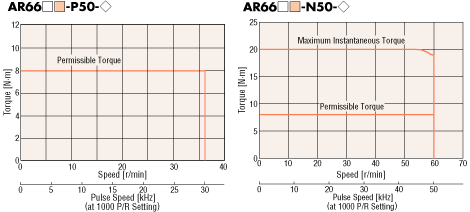What is the Difference between Maximum Instantaneous Torque and Permissible Torque?


-

Ms. Ori, can I ask you something?
-

What is it, Vex?
-

A customer asked me about geared type stepper motors, and when I look at the speed - torque characteristic graph, there are two types, permissible torque only and both permissible torque and maximum instantaneous torque. They asked me about the difference between maximum instantaneous torque and permissible torque.

-

And you don't really understand the difference.
-

That’s right.
-

Permissible torque and maximum instantaneous torque are the key points when selecting gearheads, so it's important that you can describe them properly. Here is how the catalog explains them.
Permissible Torque The torque value that is continuously applied to the gearhead output shaft. Maximum Instantaneous Torque The maximum torque value that can be applied to the gearhead output shaft. -

So, does that mean that geared motors listing maximum instantaneous torque can take a lot of torque during acceleration and deceleration?
-

That's it precisely. Do you know what are the benefits when there are a lot of torque during acceleration and deceleration?
-

Speed - torque characteristic graphs are used in selection calculations, right? And I'll calculate the acceleration torque. Oh, I get it. Being able to take large amount of acceleration torque means acceleration and deceleration times can be shortened.
-

Yes, that's right.
-

By the way, what happens when torque is applied continuously within the maximum instantaneous torque area?
-

It will work as a motor, but it'll shorten the lifetime of the gearheads. If you want to use it for a long time, it's better to use less then the maximum permissible torque when applying torque during constant speed operations.
-

I got it.
-

Also, the description of maximum instantaneous torque in the catalog mentions "load inertia," but do you remember what is the connection between the load inertia and the gearheads?
-

Let's see, isn't it that geared types are suitable for mechanisms with a large load inertia? (Please refer to the back numbers for details.)
An index table mechanisms is a typical mechanism with a large load inertia, right? -

That's right. When selecting a motor for index table mechanisms, choosing a geared type with maximum instantaneous torque will reduce the acceleration and deceleration time, which allows for quick positioning.
-

I see. Now I understand about maximum instantaneous torque and permissible torque. I will explain to the customer right away.